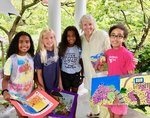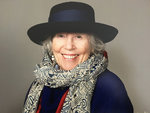After retiring from teaching in Springside School’s Middle School art department two decades ago, Lucretia Robbins saw a way to combine her passion for art, teaching and horticulture by giving her house a gift.
This item is available in full to subscribers.
We have recently launched a new and improved website. To continue reading, you will need to either log into your subscriber account, or purchase a new subscription.
If you are a digital subscriber with an active subscription, then you already have an account here. Just reset your password if you've not yet logged in to your account on this new site.
If you are a current print subscriber, you can set up a free website account by clicking here.
Otherwise, click here to view your options for subscribing.
Please log in to continue |


Artist Lucretia Robbins, 80, grew up on a farm in Bucks County with her hands in the earth and a strong connection to creation and the universe. After retiring from teaching in Springside School’s Middle School art department two decades ago, she saw a way to combine her passion for art, teaching and horticulture by giving her house a gift.
Robbins ripped up her old driveway and some scruffy grass and created a garden at her home in Wyndmoor. It was transformed into a camp where young artists could immerse themselves in nature to produce artwork during the summertime months among the lilies, hostas, zinnias and ferns, with her as their teacher.
The camp, called “Art in the Garden,” just “felt like an invitation to combine all of the things I was passionate about,” she said. “I was passionate about assisting young girls to find their creative voices in nature and in all the things that I love, painting and drawing and gardening.”
There were three rules in the garden: one was “no running,” just for safety. The second was “always sign your name” to your artwork. “We don't want any more anonymous women painters,” said Robbins. The third was just “to have fun.”
Her philosophy was not to touch students’ artwork, “I would tell students, ‘You are the artist,’” she said. And if there was something that she needed a student to know, Robbins would take them aside to tell them.
“For us, just having the extra time to focus on art and creativity was really special,” says Maggie Kyle, who was in the first group of “Art in the Garden” students 20 years ago. Kyle went on to study art and environmental science in college and now designs jewelry.
Marilyn McCullough, another of Robbins’ first students, describes her experience in the garden as always feeling so “calm and easy.” She discovered an appreciation for the small wonders of the garden when Robbins handed out viewfinders to students ... The lesson related to them: “You are in a special place right now; remember the special parts of it.”
One exercise with a viewfinder, of which there were many, stands out to McCullough vividly, when the campers learned to appreciate the different shades of green around them: “Take a look at the different shades of green,” said McCullough. “Don’t focus on possibly painting even a flower, but take a look at the different textures, shades, the way light captures the color.”
It was a supportive environment for campers, who developed skills in a variety of art mediums: watercolor, colored pencil, acrylic paint, oil and chalk pastels and collage. The students also gathered around a wooden table, hidden among the blooms and the foliage, to eat Robbins’ homemade blondies, drink lemonade and celebrate summertime birthdays to the sound of chirping birds.
Encouraging students to immerse themselves in nature, Robbins spoke to them about the wildlife and the birds that they could hear in the garden. Once a camper came to class with earbuds, and Robbins encouraged her to abandon them and listen to nature as she worked. The student asked “Why?” and Robbins said, “Well, you might hear something that you haven’t heard before.” And sure enough, at the end of class, the student said to Robbins, “I don't know what it was, but I heard an amazing bird song.”
One Thursday morning a student came to camp in tears after having a successful week creating “beautiful work,” said Robbins. “Her daddy had brought her, and he took me aside and said, ‘Her grandfather, who she loves so much, passed away last night.’
“But, here she was, coming to Art in the Garden, and she wanted to stay. I said to her, 'You know, I'm quite a bit older than you are, but in my life, making my art has helped me get through some really sad times.’ So, after the snack, I checked in with her. I said, ‘Is it working?’ And she said ‘It's working.'”
To learn more about horticulture, Robbins signed up for a three-year program at the Arboretum School of the Barnes Foundation. “I was told by my first teacher at the Barnes that I would never be a 'true botanical illustrator ... because you have your own style!’ I was in my 60s then, and I said, ‘If I don’t have my own style by now, I’m giving up!’”
A former art teacher colleague of Robbins at Springside School, Kathy Giovinazzo, also began to study botanical illustration upon retiring. She and Robbins took their botanical illustration studies to the National Tropical Botanic Garden in Kauai, Hawaii. They studied there for four winters but missed this year due to Covid risk.
Robbins will not be re-opening her garden to students this summer. In fact, this is the year she will retire, and Art in the Garden will close its doors after 20 successful years. Robbins will also be hosting an art sale at her studio in May.
Freelance writer and author Elspeth Lodge, of Lafayette Hill, was in the first group of “Art in the Garden” students and later worked as a counselor at the camp. For more information, visit lucretiarobbins.com.